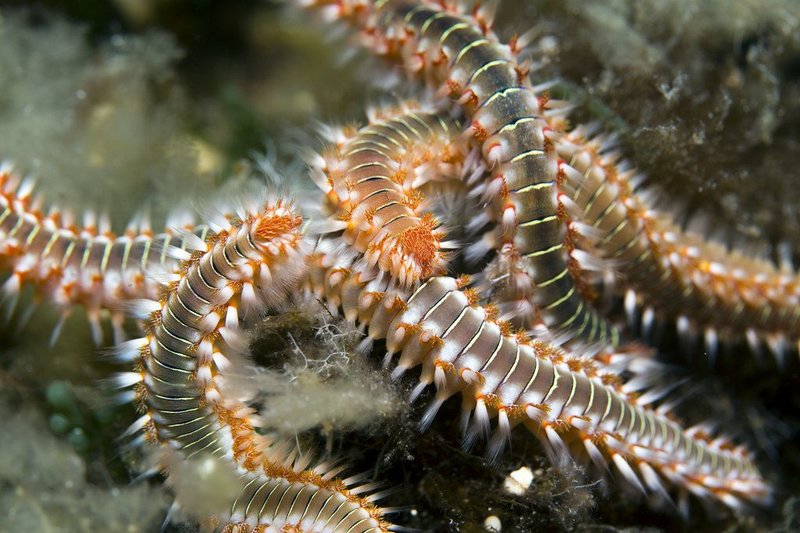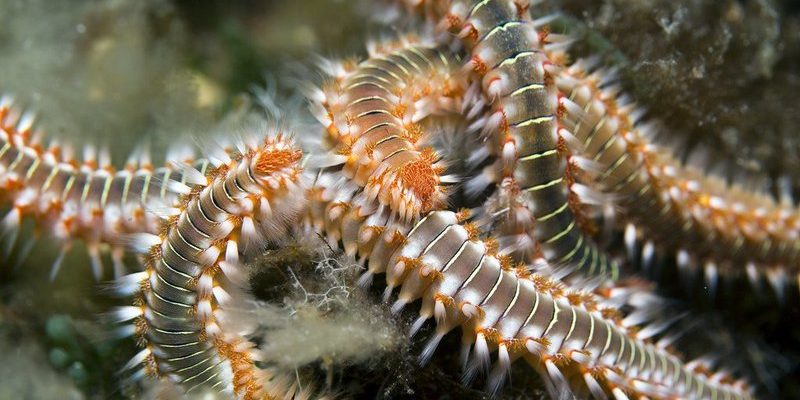
Bristle worms, often found in both freshwater and saltwater aquariums, are part of a larger group of creatures called polychaetes. They’re generally harmless and play a vital role in breaking down organic matter, but when their population gets out of control, they can wreak havoc on your tank’s balance. Let’s dig into how you can manage these little critters right from the start.
What Are Bristle Worms?
Bristle worms are segmented worms that can vary in color and size, making them somewhat challenging to spot at first. Often, they’re flesh-colored or brown, and their bodies are bristly, which gives them their name. You might find them hiding under rocks or in the substrate, blending in with their surroundings. They can grow quite long—up to ten inches or more in some species—so they can easily surprise you if you’re not prepared.
You might be wondering why something so small can be a big deal. The truth is that while bristle worms can help keep your tank clean by consuming detritus and leftover food, an *overpopulation* issue can lead to aggression toward your tank’s inhabitants. They might start nibbling on corals or shrimp if they’re too numerous. So, it’s vital to keep their numbers under control, especially during setup.
Signs of a Bristle Worm Infestation
Recognizing the signs of bristle worm overpopulation is critical. If you’re setting up your tank and notice any of the following, it might be time to take action:
- Visible Worms: If you see several bristle worms while doing a tank inspection, they may be reproducing faster than you can manage.
- Damage to Corals: If your corals look like they’ve been munched on, bristle worms might be the culprits.
- Unusual Behavior: Observe your tank inhabitants—if they seem stressed or are hiding more than usual, there could be too many worms in the mix.
Monitoring these signs early on can help you prevent a full-blown outbreak. You certainly don’t want your tank turning into a bristle worm paradise instead of the aquatic haven you envisioned.
Preventing Bristle Worm Outbreaks
Now that you know what bristle worms are and how to spot them, let’s discuss prevention. After all, it’s much easier to keep these little guys in check than it is to eliminate them once they’ve taken over. Here are some steps you can follow:
1. **Choose Clean Live Rock:** When setting up your tank, make sure to select live rock that’s free from visible pests. A quarantine period can help if you’re unsure about the cleanliness of your source.
2. **Manage Feeding Habits:** Overfeeding is one of the main reasons for a bristle worm population explosion. Stick to a routine and only feed your fish what they can eat in a few minutes to reduce excess food that might attract these worms.
3. **Regular Maintenance:** Regularly cleaning your tank and removing detritus will minimize the food source for bristle worms. A clean tank is less appealing to unwanted visitors.
By implementing these preventive measures early in your tank setup, you can significantly reduce the risk of encountering a bristle worm outbreak.
Dealing with Bristle Worms if They Appear
So, what if you’ve already started to notice those pesky bristle worms showing up? Don’t worry; there are ways to manage an outbreak effectively:
1. **Manual Removal:** If you spot the worms, you can remove them by hand. Use gloves, as their bristles can cause irritation. Carefully pull them out and dispose of them, being mindful not to harm other inhabitants.
2. **Trap Them:** There are commercially available traps designed specifically for bristle worms. These can be a great way to catch and relocate them without causing harm to your tank.
3. **Introduce Predators:** Some fish, like certain wrasses or dottybacks, will eat bristle worms. By adding compatible species, you can naturally keep their numbers in check.
Addressing the issue quickly helps maintain the balance in your aquarium. Remember, the goal is to create a harmonious environment for all your aquatic life.
Creating a Balanced Ecosystem
A healthy aquarium is all about balance. To prevent further outbreaks, you need to ensure that all levels of your tank, from water quality to nutrient levels, are appropriate. Here’s how you can maintain that balance:
– **Regular Water Changes:** Regularly changing out a portion of your tank water can help remove excess nutrients that bristle worms love. Aim for a 10-15% change every week to keep things fresh.
– **Use Quality Filtration:** A good filtration system will help maintain water clarity and quality. Be sure your filter is appropriate for your tank size and setup.
– **Maintain Proper Lighting:** If you’re keeping corals, ensure they receive the right amount of light for their growth. Proper lighting can encourage healthy growth and keeps your coral collection strong, making them less susceptible to predators like bristle worms.
Creating this balance will not only keep bristle worms at bay but will also promote a thriving tank ecosystem.
When to Call in Professional Help
Sometimes, despite your best efforts, an outbreak can get out of hand. When is it time to seek help? Here are a few indicators:
– **Significant Damage:** If the bristle worms are causing noticeable damage to corals or fish, it may be time to consult with an aquarium professional.
– **Difficulty Managing:** If you find yourself overwhelmed by the number of bristle worms and can’t keep up with removal or trapping, don’t hesitate to reach out to someone who has more experience.
– **Specialized Treatments Needed:** In severe cases, there may be treatments available that you might not be aware of. Professional aquarists often have access to more advanced solutions.
Remember, there’s no shame in asking for help. Your goal should be a safe and healthy environment for your aquatic friends.
Managing bristle worm outbreaks during your tank setup might seem daunting, but with a bit of knowledge and proactive measures, you can navigate this challenge smoothly. Remember, these tiny creatures can be both helpful and harmful. The key is to strike the right balance.
As you set up your tank, keep your eyes peeled for signs of bristle worms and take preventive steps to keep their numbers down. Be diligent about maintaining your aquarium, and don’t hesitate to seek help if necessary. Enjoy the process, and soon enough, your tank will flourish, becoming the peaceful aquatic haven you’ve always dreamed of.

